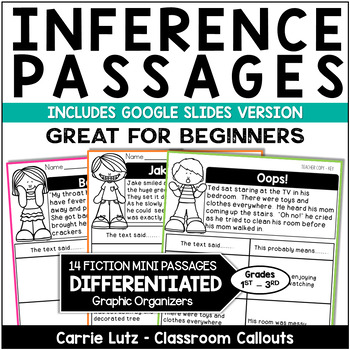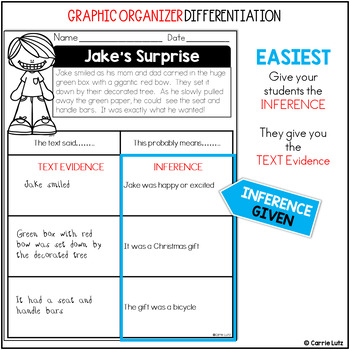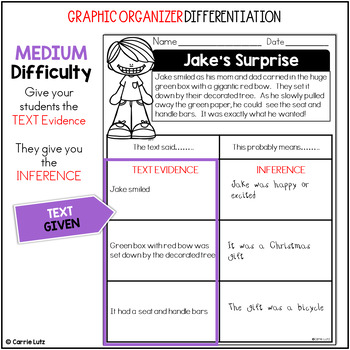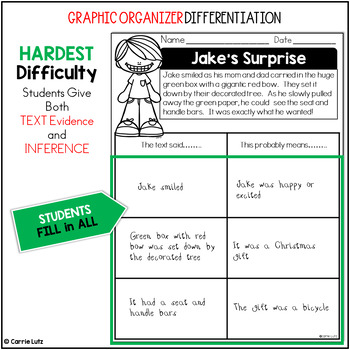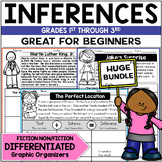Inferencing Passages Making Inferences Worksheets Graphic Organizers
- PDF
- Google Apps™
- Easel Activity

What educators are saying
Also included in
- This Making Inferences Bundle can save you valuable time when looking for an effective resource for teaching inferring to young learners. It's great for beginners and struggling students alike. Included are 25 short fiction and nonfiction passages with 3 built-in inferences each! No more scouring thPrice $10.10Original Price $11.25Save $1.15
- Are you scouring through dozens of books to find examples of Making Inferences text, only to find maybe one good example of an inference? I felt like I was doing that WAY too much! That's exactly why I created this resource with 3 built-in inferences in each little passage. Great for Summer School!$Price $23.00Original Price $32.00Save $9.00
Description
Are you scouring through dozens of books to find examples of Making Inferences text, only to find maybe one good example of an inference? I felt like I was doing that WAY too much! That's exactly why I created this resource with 3 built-in inferences in each little passage. Great for Summer School!
The short passages are intentional. Short and to the point. Watch the Video Preview so see how to use this resource.
You also get to choose which skill you want your students to work on.
- Give them the inference. Then, just ask them for the supporting text. Supporting texts are RIGHT THERE. Inferences are NOT!
- Give them the supporting text and ask for the inference. Once they've done #1, this will be A LOT easier.
- Finally, use the passage with the blank organizer and ask for both supporting text & inference.
Tons of Feedback like this one:
"This was great for beginning inferences! The practice was very helpful and I loved there were different choices for each text. It was very helpful in scaffolding my different groups of students. The texts were also level appropriate. Thank you!"
- Extraordinary ELA
Scaffold the Instruction:
This resource has several way to scaffold the instruction: See the Video Preview.
- Day 1 - Model the skill of your choice (Example Give the Supporting Text)
- Day 2 - Using the same passage, have them give you the Inference. This way, they are already familiar with the text and it will build confidence.
- Day 3 - Assign the same passage with the blank organizer so they can give you the supporting text and the inference.
Making Inferences is a difficult skill for both teachers and kids. But, with the included mini passages, inferring can be made a little easier. The inferences are built right in and the passages are short so they do not overwhelm kids that are struggling with inferring.
Just Added! Google Slides Version Link inside resource.
⭐ GREAT FOR BEGINNERS! ⭐
This resource uses REVERSE INFERRING. This means that you give the Inference to the student and they must come up with the text evidence that implied the inference. This is easier than inferring the traditional way. After they master Reverse Inferring, they move on to Traditional Inferring.
The passages are super short which makes it look easy so it takes the stress off of the child. The reading level is not super hard, so that helps, too. What really happens is that kids learn what it means to infer. There are 3 Inferences in each passage.
By differentiating the graphic organizers, you can use the GRADUAL RELEASE MODEL.
When you completely model the easiest one ( giving them the inference and having them give you the text ) they will become more confident when you have them try with a partner then on their own.
Do this with each level until they can do the blank graphic organizer on their own.
For Kids, sometimes the reading level is a hindrance and if kids can't read the material, they can't learn the skill.
For Teachers, finding material that really helps their students with this difficult concept can be a problem. That's where this resource comes in!
Here's what Jodie had to say:
"I absolutely LOVE this! If I could give it an A + then I would!!! Great for speech/language therapy. I have used them with kids in 2nd- 4th grade. I love it how there are 2 times of inference activities for each passage."
More About This Product:
These mini-passages are just the right length for teaching INFERRING to young or struggling readers. The reading is on a lower level so kids aren't frustrated by the text difficulty. This way they can completely focus on the skill of MAKING INFERENCES.
So … These passages can also be appropriate for higher grades with a low reading level, such as Special Education, Learning Disabilities, etc.
There are 14 kid friendly mini-passages with an inferring graphic organizer for each. The text are all pretty simple. The work is differentiated, not the text.
Because I know how busy teachers are, I have provided a key for each passage.
Differentiation –The Graphic Organizers are DIFFERENTIATED.
• BELOW LEVEL STUDENTS: Give the students the INFERENCE and allow them to give you the text. Always MODEL one Entire passage first. Then have them work with a partner on the next one. Finally, see if they are ready to try it independently. (Gradual Release Model)
• ON LEVEL STUDENTS: Give the students the TEXT and allow them to give you the INFERENCE. This is a bit more difficult because they will need to bring in some background knowledge to do this.
• ABOVE LEVEL STUDENTS: Give the Students a passage with a Blank Graphic Organizer. They will need to find all three inferences and the text that led them to them.
One thing I have found is that if you use the word "BECAUSE" to make a connection between what the text says and what it probably means, the students AREN'T as likely to write something that doesn't make sense.
Check out the preview!
Copyright © Carrie Lutz Classroom Callouts
All rights reserved by author.
Permission to copy for single classroom use only.
Need More Inferring Resources?
⭐ FREE Making Inferences Passages with Graphic Organizers
⭐ Making Inferences Passages with Graphic Organizers
⭐ MAKING INFERENCES PASSAGES BUNDLE
⭐ Making Inferences PASSAGES NONFICTION
⭐ Making Inferences Reading Passages
⭐ Making Inferences with Idioms - Figurative Language Practice
Be sure to rate this product and provide feedback to earn TpT credits good toward the purchase of future products!
Let's Connect!
Search Key Terms:
| common core | inferring | inference| making inferences | passages | fiction | reading | comprehension | strategies | strategy | graphic organizers | reading comprehension | worksheets | literacy | stations | differentiated | inferencing | reading comprehension passages | making inferences reading passages | making inferences reading comprehension passages | reading comprehension strategies | inferring passages | inferring worksheets | making inferences worksheets with answer key | making inferences worksheets |

